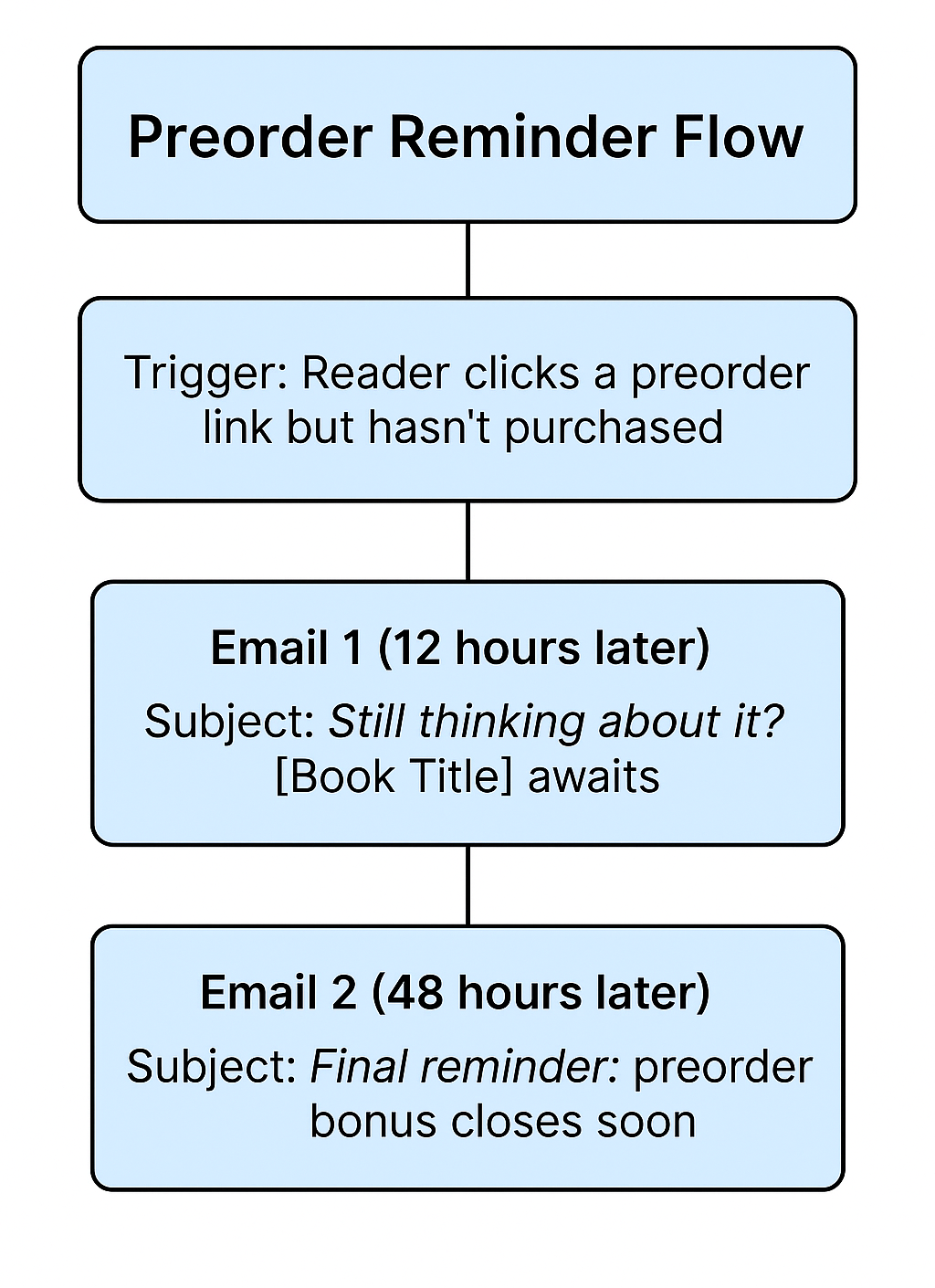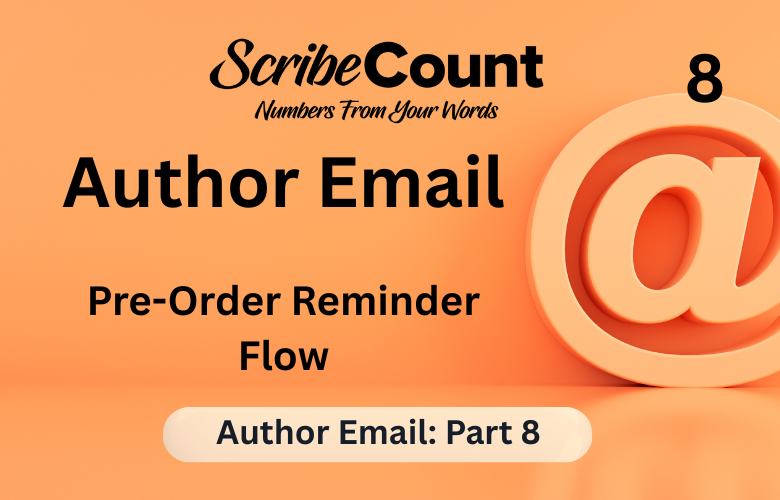Preorder Reminder Flow for Indie Authors: Nurturing Interest into Action Before Launch Day
A well-executed book launch doesn’t begin on release day—it begins the moment your book becomes available for preorder. That window between announcement and release is one of the most important marketing opportunities an indie author can leverage. Yet, without a structured Preorder Reminder Flow in place, it’s easy for potential readers to express interest—and then forget.
The Preorder Reminder Flow is your secret weapon for turning curiosity into conversions. It bridges the gap between awareness and action, providing strategic, gentle nudges that build excitement and encourage readers to click "buy" before launch day even arrives.
This guide will walk you through every detail of crafting a Preorder Reminder Flow: what it is, how it works, how to write it, when to send it, and how to track results using tools built for indie authors. When paired with a solid Welcome and New Release Flow, your preorder strategy becomes a powerful revenue and visibility engine.
What Is a Preorder Reminder Flow?
A Preorder Reminder Flow is an automated sequence of emails that encourages readers—especially those who’ve shown interest—to complete their preorder before your official launch day. It targets those who have clicked on a link to your preorder listing, downloaded a free sample, opened a previous launch announcement, or joined your list during the promotion window.
It’s not about spamming your whole list. It’s about smart, behavior-based messaging.
At its core, a Preorder Reminder Flow answers two questions for readers:
- Why should I preorder?
- Why should I do it now?
To better understand the power of a well-timed reminder flow, consider this real-world example: Indie fantasy author Elise Carter ran a 21-day preorder campaign for her trilogy finale. After announcing the book to her list, 327 subscribers clicked through to read the description—but only 56 preordered within the first few days. Instead of assuming interest had fizzled, she used a three-email Preorder Reminder Flow over the following week. Each message included exclusive character art, a bonus chapter for early buyers, and a personal note about her journey writing the final book. By launch day, 233 of those original 327 clickers had completed their purchase—quadrupling her initial conversion rate. More importantly, she saw a bump in her series’ ranking across multiple platforms, which helped drive additional sales from new readers.
That’s the power of a Preorder Reminder Flow—not just reminding readers, but reigniting their excitement and guiding them toward action at exactly the right time.
A Preorder Reminder Flow is an automated sequence of emails that encourages readers—especially those who’ve shown interest—to complete their preorder before your official launch day. It targets those who have clicked on a link to your preorder listing, downloaded a free sample, opened a previous launch announcement, or joined your list during the promotion window.
It’s not about spamming your whole list. It’s about smart, behavior-based messaging.
At its core, a Preorder Reminder Flow answers two questions for readers:
- Why should I preorder?
- Why should I do it now?
Why Preorders Matter for Indie Authors
While traditional publishers have long used preorders to gauge demand and drive bestseller placement, indie authors are now using them to:
- Build momentum before launch
- Boost early sales rankings on platforms like Amazon
- Collect proof of concept for future books
- Offer preorder bonuses (artwork, deleted scenes, early access)
- Set up review teams before release
But the strategic value of preorders goes even deeper—especially when it comes to discoverability.
On Amazon, preorder activity can influence how your book is treated by the algorithm. Strong early traction—such as consistent preorders, page visits, and clicks—sends a signal that the book is gaining interest. In response, Amazon may begin surfacing it more often in search results, "also bought" carousels, and recommendation lists. That visibility snowballs, helping you reach new readers organically.
Other retailers like Apple Books and Kobo often showcase preorder titles in curated collections. If your book gains momentum early, it’s more likely to be considered for these front-page features. These platforms reward proactivity, and authors who build effective preorder strategies are often the ones who end up with better placement and long-term traction.
Most importantly, a preorder campaign turns your passive subscribers into active, invested readers. When a preorder flow is done well, it plants emotional hooks early, builds anticipation, and smooths the transition into your New Release Flow.
While traditional publishers have long used preorders to gauge demand and drive bestseller placement, indie authors are now using them to:
- Build momentum before launch
- Boost early sales rankings on platforms like Amazon
- Collect proof of concept for future books
- Offer preorder bonuses (artwork, deleted scenes, early access)
- Set up review teams before release
Most importantly, a preorder campaign turns your passive subscribers into active, invested readers. When a preorder flow is done well, it plants emotional hooks early, builds anticipation, and smooths the transition into your New Release Flow.
Structure of an Effective Preorder Reminder Flow
This flow typically includes 2 to 4 targeted emails spaced over a 1–3 week period. It begins once a reader clicks a link to your preorder page (on Books2Read, Kobo, Apple Books, or Amazon).
Here’s a typical format:
Email 1: Interest Confirmation (Immediate after link click)
Subject: “Thinking about it? Here’s what’s waiting…”
This is a soft follow-up that reinforces the value of the book. You can highlight early reviews, exclusive preorder bonuses, or a special offer for early birds. Think of it as a friendly, helpful reminder.
Email 2: Social Proof + Scarcity (2–3 days later)
Subject: “Readers are already excited about this book—are you in?”
Now you shift into persuasive territory. Include reader comments, ARC feedback, or influencer endorsements. You can also tease a limited-time bonus, like early access or a preorder-only download.
Email 3: Final Call (1–2 days before launch)
Subject: “Last chance for preorder perks!”
This is your urgency email. Remind readers of what they’ll miss if they don’t act. Include a countdown or teaser of the next phase (launch bonuses, surprise release-day content, etc.).
Optional Email 4: Day-of Confirmation (Morning of launch)
Subject: “Your preorder is ready. Here’s what happens next.”
This email is especially useful for direct-sales preorders or if you’re launching wide across multiple platforms. Reinforce next steps and remind readers to check their inbox or device for delivery.

What to Include in Your Preorder Reminder Emails
The most successful Preorder Reminder Flows are crafted like mini-stories. Each email should build upon the last, adding a new reason for the reader to act, a new insight about your book, or a personal connection that deepens trust.
Start with a cover image—this visual anchor is your brand in action. Seeing a polished, consistent design reminds readers that the book is real, imminent, and professionally produced. It sparks recognition with each email, especially if you’re sharing on social media as well.
Next, always include buy links that direct readers to every major platform where your book is available. To simplify this, services like Books2Read allow you to generate a single smart link that routes readers based on their device or location. Repeating this link at the top and bottom of your email ensures that readers never have to hunt for the next step.
If your book ties into a reader magnet—like a prequel novella or bonus short story—reference that connection. Remind readers they’ve already entered your world, and this book expands it. It helps them visualize where they are in your series or universe, and reinforces that they’re not starting from scratch.
Bonuses are where many preorder flows shine. Whether it’s exclusive artwork, deleted scenes, alternate endings, or a private Q&A video, offering something only available to preorder customers incentivizes action. Use BookFunnel to securely deliver digital rewards, and mention that the bonus vanishes after launch day.
Finally, take the time to write personal notes. This might be a paragraph about what inspired this book, a moment that nearly derailed the process, or a behind-the-scenes milestone. Readers love seeing the human side of the author, and it’s often this authenticity that transforms a passive reader into an enthusiastic supporter.
Every element should be intentional, leading the reader toward one thought: I don’t want to miss this.
The most successful Preorder Reminder Flows are crafted like mini-stories. Each email adds something new: a reason to trust, a reason to act, a reason to stay.
Here’s what to include:
- Cover Image – Visual consistency is key. Use the same professional cover throughout the flow.
- Buy Links – Include direct links to every platform you’re distributing through. Use Books2Read to consolidate.
- Reader Magnet Tie-in – Mention if this book connects to a free prequel or sample already in their inbox.
- Bonuses – Offer preorder-exclusive content. Use BookFunnel to deliver bonus scenes, artwork, or alternate endings.
- Personal Notes – Share your excitement, the journey to this book, or a milestone the preorder helped you reach.
Tools to Build Your Flow
Just like your Welcome and Launch Flows, this sequence can be built using your ESP:
- ConvertKit: Segment readers who click on links or visit a landing page.
- MailerLite: Create automations based on click behavior and tags.
- ActiveCampaign: Create complex logic flows for multiple book launches.
- FloDesk: Keep it simple and beautiful with basic triggers and automations.
- Klaviyo: Great for Shopify authors running preorder campaigns through direct sales.
Use StoryOrigin or BookFunnel for timed bonus delivery and tracking.
Mistakes to Avoid
- Sending to everyone: Preorder Flows work best when behavior-triggered.
- Sending too soon or too often: Space them out. Let curiosity breathe.
- Too much pressure: Keep tone friendly, not salesy.
- Missing buy links: Always double-check platform URLs.
What Happens After the Preorder Flow?
Once your reader preorders, tag them as "preordered" in your ESP. Then move them automatically into:
- Your New Release Flow on launch day
- A thank-you email with bonus delivery
- A review request sequence if you're delivering early copies
If a subscriber clicked but didn’t buy, move them into a gentle follow-up series post-launch.
Final Thoughts: Guide the Reader, Don’t Push Them
Preorder Reminder Flows are about more than just conversions—they’re about cultivating trust and emotional investment. When someone clicks on a link, signs up for a sample, or otherwise shows interest in your upcoming book, they’re not asking to be pressured. They’re asking to be guided. Your job as an indie author is to respect that interest and offer value in return.
Preordering is an inherently psychological act. Readers who preorder are demonstrating both anticipation and loyalty—they’re committing to a book they haven’t read yet, based on a promise. That promise might be the strength of your past work, a compelling premise, a stunning cover, or a heartfelt story. The role of a reminder flow is to reinforce that decision with subtle, supportive communication.
Value-added messaging makes a difference. Instead of repeating the same sales message, your emails should deepen the reader’s connection to you, the book, or the characters. Share exclusive behind-the-scenes insights. Offer a peek at the writing process. Thank them for being part of your journey. These touches convert curiosity into commitment, and one-time buyers into loyal fans.
Set your Preorder Reminder Flow up once, test and tweak it with each launch, and trust in its long-term benefits. Because when it’s done right, it doesn’t feel like marketing. It feels like a conversation between writer and reader—right where the magic happens.
Preorder Reminder Flows are about trust. When someone shows interest, they’re inviting you to remind them. These emails aren’t interruptions—they’re assistance. Timely, helpful, well-crafted reminders build stronger engagement, better launches, and loyal fans.
Set them up once, automate the logic, and watch your preorders climb.

